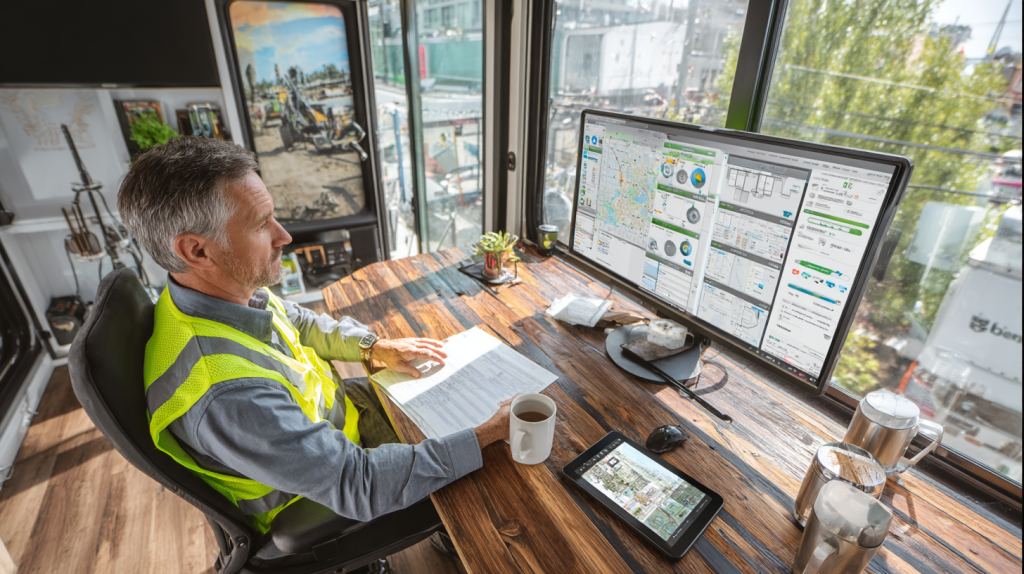Top Construction Materials Tracking Software for Inventory, Deliveries, and Jobsite Control
Table of Contents:

In construction, materials are the lifeblood of the project—but without proper tracking, they can become one of the biggest sources of chaos. Materials arrive late, go missing, pile up in the wrong location, or simply don’t match what was ordered. For general contractors and superintendents tasked with keeping projects on time and on budget, having the right materials tracking software is essential.
Modern tracking platforms give teams real-time visibility into what’s been ordered, where it’s stored, when it’s arriving, and whether it’s ready for install. They help prevent rework, eliminate double orders, and reduce costly delays due to inventory confusion. Most importantly, they create a single source of truth across procurement, logistics, and the jobsite—keeping everyone aligned and responsive
In this blog, we’ll break down the top capabilities of materials tracking software, how these tools improve delivery accuracy, inventory management, and jobsite control, and what features are most valuable for growing construction teams.
What Is Construction Materials Tracking Software and Why Is It Needed?
Construction materials tracking software is a specialized tool that monitors the status, location, and movement of building materials from procurement to final installation. Unlike generic inventory systems, these platforms are tailored for the fast-moving, multi-location, and often unpredictable world of construction. They help field and office teams stay coordinated by providing real-time data on inventory levels, delivery schedules, usage, and material conditions.
Without proper tracking, construction teams risk delays, overordering, missing components, or rework caused by incorrect specs or late deliveries. Materials tracking software solves this by making the flow of materials transparent and manageable. Features like barcode scanning, mobile check-ins, digital delivery logs, and integrations with procurement and scheduling tools help keep every team member informed and aligned.
Whether you’re managing a single jobsite or multiple projects, these platforms provide the visibility needed to maintain momentum, reduce loss, and keep your builds moving forward.
Top Benefits
- End-to-end visibility into material status
Know what’s ordered, what’s in stock, and what’s arriving across all projects and storage locations. - Real-time coordination between field and office
Everyone from supers to procurement sees the same information—reducing errors and delays. - Improved inventory accuracy and forecasting
Better tracking means smarter reordering, less waste, and more control over project costs.
Best Practices
- Tag materials by trade, area, or phase
Help crews understand what’s needed and where it goes—preventing staging and sequencing mistakes. - Set up delivery logs with mobile photo verification
Allow field teams to document deliveries instantly and notify office staff in real time. - Use alerts for key delivery or inventory thresholds
Get notified when critical items are delayed, missing, or low in stock to respond proactively.
Materials tracking software turns a chaotic supply chain into a manageable workflow—giving your team clarity, speed, and control.
How Does Materials Tracking Software Improve Inventory Management?
Inventory mismanagement is one of the top causes of project delays, waste, and cost overruns. On busy jobsites, materials often go untracked—left on pallets, stored in the wrong location, or used without documentation. Materials tracking software brings structure to this chaos by turning your inventory into a digital, searchable, and constantly updated asset.
These platforms allow you to monitor inventory levels across multiple job sites, laydown yards, warehouses, or mobile trailers. Each item can be logged with a quantity, location, and condition—and tracked as it moves from delivery to staging to installation. When inventory is low, the system can alert your team automatically, prompting reorders or transfers.
More advanced systems even include batch tracking, consumption rates, and cost tagging, helping project managers forecast needs, reduce material hoarding, and avoid double ordering. Barcode scanning and mobile input ensure that data entry is fast, accurate, and field-ready.
Top Benefits
- Live visibility into what materials are on hand
Prevent overstocking or shortages by always knowing current quantities and locations. - Faster, more accurate material reconciliation
Match POs to deliveries and usage to detect discrepancies and avoid invoice errors. - Improved budget accuracy through tighter control
Track materials by cost code or trade to see where you’re spending and identify waste.
Best Practices
- Use mobile apps to update inventory from the field
Allow foremen or warehouse staff to scan materials in or out without needing a laptop or paper logs. - Set reorder points and par levels for common materials
Automate alerts and reduce downtime by ensuring replenishment happens on schedule. - Conduct weekly cycle counts on high-turnover items
Focus inventory checks on frequently used materials to maintain accuracy without extra admin burden.
Good inventory management gives your teams the tools to move faster, waste less, and stay on budget—all from the palm of their hand.

Related Articles:
The Construction Site Coordination Platform Built for Field Teams: StruxHub
How Can These Tools Improve Delivery Coordination and Accuracy?
Late, missing, or misdelivered materials are more than just a hassle—they’re a project risk. When deliveries don’t arrive on time, arrive incomplete, or end up at the wrong site, your schedule suffers and your crews sit idle. Materials tracking software helps eliminate this issue by streamlining delivery coordination and creating a real-time, verifiable record of what was delivered and when.
These tools allow procurement teams to input expected delivery dates, shipment tracking numbers, and vendor contacts directly into the system. Field teams can then see what’s arriving, prepare staging areas, and confirm receipt—all from their phone or tablet. Most platforms include delivery verification tools like photo uploads, signature capture, and condition notes, which improve accountability and reduce disputes.
In addition, you can assign deliveries to specific tasks, trades, or work areas—helping supers coordinate crew work based on real-time material readiness. This results in better planning, fewer missed inspections, and smoother project flow.
Top Benefits
- Improved delivery accuracy and fewer missing items
Delivery logs with photo evidence create clear documentation and reduce vendor disputes. - Faster field-level responses to delivery changes
Supers get real-time alerts about delays or changes so they can adjust plans accordingly. - Better sequencing of materials to match work phases
When deliveries are tied to scheduled work, crews install faster and avoid rework.
Best Practices
- Use delivery tags to assign tasks or approvals
Let specific team members verify certain items and flag discrepancies directly in the system. - Link deliveries to schedule milestones
Ensure materials arrive in sync with planned work—not too early, not too late. - Keep a shared dashboard for expected deliveries
Make incoming shipments visible to field teams, logistics coordinators, and procurement staff.
With real-time delivery tracking, your jobsite runs smoother, crews stay productive, and your vendors stay accountable.
How Does Materials Tracking Improve Jobsite Control and Workflow?
Without clear materials tracking, jobsite control quickly breaks down. Crews arrive ready to work, only to discover the required materials are still in transit—or worse, never ordered. Supplies are stored in the wrong areas, critical deliveries are missed, and productivity stalls. Materials tracking software brings order to this environment by making real-time inventory and delivery data accessible where it matters most: in the field.
When foremen and superintendents can see exactly what materials are available, what’s incoming, and what’s delayed, they can make smarter decisions about staging, labor, and task sequencing. They no longer need to rely on emails or phone calls for material updates—everything they need is in the system, linked to live schedules or specific tasks.
The result is tighter coordination across trades, fewer bottlenecks, and reduced risk of idle labor. Materials tracking becomes a core driver of project momentum, keeping crews focused, organized, and working in sync with delivery timelines and phase requirements.
Top Benefits
- Clear line of sight for field teams into material readiness
Superintendents can plan ahead and make real-time adjustments based on accurate inventory data. - Stronger sequencing and trade handoffs
Know exactly when materials for a task or trade will be ready to support efficient handoffs. - Fewer disruptions from last-minute surprises
Real-time alerts and delivery confirmations prevent blindsiding the team with unplanned shortages or errors.
Best Practices
- Connect deliveries to work areas and trade scopes
Organize materials and install sequences by location to support efficient movement across the site. - Review material readiness during daily huddles
Use real-time tracking dashboards to keep everyone on the same page and identify risks early. - Assign clear ownership for material verification tasks
Designate field leads to check quantities and conditions so nothing slips through the cracks.
When materials tracking is tied directly to jobsite workflows, you gain control—not just visibility.
Related Articles:
Best Guide to AI in Construction Project Management: How Smart Tools Are Improving Construction Site Productivity; AI
Best Guide to Geographic Information Systems (GIS) in Construction: How Location-Based Data Improves Construction Project Management
Best Guide to Smart Helmets in Construction: Enhancing Safety, Communication, and Site Efficiency
Best Construction Scheduling Software for General Contractors and Superintendents
Best Guide to Solar Farm Construction Management: Top Solar Construction Management Software for Tracking Projects, Deliveries, and Compliance

How Can These Tools Reduce Risk and Strengthen Compliance?
Every project comes with risk: incomplete deliveries, misplaced materials, failed inspections, and legal claims related to faulty installations. Materials tracking software acts as a safeguard by ensuring that every item received is logged, verified, and documented.
With features like photo documentation, timestamped delivery records, and document attachments (spec sheets, MSDS, compliance certificates), these tools make it easy to prove what was delivered, when, and in what condition. That means fewer disputes with vendors, more reliable closeout documentation, and stronger protection in case of litigation.
Materials tracking also supports compliance with regulatory requirements, safety protocols, and LEED or sustainability goals. You can monitor usage of certain material types, validate proper storage conditions, or confirm that only approved materials were used for specific scopes of work.
By digitizing this entire process, your team saves time and avoids paperwork bottlenecks—while reducing costly mistakes that could delay handoffs or jeopardize client trust.
Top Benefits
- Better documentation for audits, inspections, and disputes
Digital records provide proof of compliance, delivery accuracy, and on-site verification. - Reduced liability from incorrect or damaged materials
Catch and document issues early to avoid rework or safety concerns later. - Improved closeout and warranty documentation
Materials tracking simplifies the collection of manuals, compliance sheets, and warranty info for turnover packages.
Best Practices
- Log photos of high-value or high-risk materials at delivery
Capture conditions to support warranty claims or prevent installation of incorrect items. - Attach compliance documents directly to material entries
Make it easy to retrieve supporting documentation during inspections or handoff. - Standardize materials intake procedures across sites
Create a consistent process to reduce risk and improve audit readiness across all projects.
Materials tracking is more than logistics—it’s a smart risk management tool that pays off at every phase of the project.
How Does Materials Tracking Improve Communication Across the Project Team?
Materials delays and miscommunications often happen not because teams aren’t doing their jobs—but because they’re not working from the same information. Procurement knows what was ordered, logistics tracks what was shipped, but the field doesn’t always know what to expect—or when. Materials tracking software eliminates these silos by creating a shared, real-time data layer for everyone involved.
When your entire project team can see material status in one place—whether they’re in the field, in the office, or with a vendor—they can coordinate tasks more efficiently. Questions like “Did it arrive?” or “Where’s that order?” don’t require a phone call or a visit to the trailer. Instead, teams can access delivery logs, inventory status, and task assignments from their phones or laptops.
This shared visibility improves trust, reduces duplication, and increases accountability. Everyone—from the project manager to the warehouse coordinator—works from the same up-to-date information, reducing confusion and speeding up resolution.
Top Benefits
- Real-time collaboration across departments
Office and field teams share live data, reducing misunderstandings and unnecessary delays. - Streamlined issue resolution for material delays or errors
Problems are identified quickly and logged in the system—no more blame games or finger pointing. - Clearer task ownership for material-related activities
Track who requested, received, or verified items with timestamps and notes.
Best Practices
- Set up shared dashboards for inventory and delivery tracking
Let procurement, field, and PM teams all work from the same source of truth. - Use automated alerts for critical items
Notify relevant stakeholders immediately when materials are delayed or received. - Link materials updates to coordination meetings
Make delivery and inventory status a standard agenda item for project reviews.
Good communication builds good projects—and materials tracking software helps your whole team speak the same language.
How StruxHub Supports Field Visibility for Materials Tracking
StruxHub doesn’t replace your materials tracking platform—it makes it usable and visible where it matters most: in the field. Many tracking systems collect data at the office level, but the information often doesn’t reach superintendents, foremen, or crew leads when they need it. That’s where StruxHub steps in.
As a field coordination platform, StruxHub connects materials status directly to daily task planning, progress tracking, and delivery workflows. It gives field teams a real-time look at what’s been ordered, what’s been received, and what’s delayed—so they can adjust without waiting for calls or emails from the office.
Material-related tasks can be created, tagged, and assigned inside StruxHub. You can mark deliveries as pending, schedule installation based on material readiness, or trigger a follow-up if something arrives incomplete. Teams can upload photos, leave notes, and close the loop quickly.
Most importantly, StruxHub integrates materials communication into the jobsite’s daily rhythm—so your team never has to stop building just to find out where something is.
Top Benefits
- Task-level visibility for materials delivery and usage
Assign, track, and confirm materials-related activities as part of your daily jobsite workflow. - Improved speed of response to delivery issues
Field teams can document and report problems immediately—no delay, no miscommunication. - Stronger alignment between procurement, field ops, and logistics
Everyone sees what’s happening, what’s needed, and what’s next—without asking twice.
Best Practices
- Tag material-sensitive tasks with delivery status
Make “awaiting delivery” or “material ready” part of your task planning language. - Include materials notes in daily StruxHub updates
Keep field conditions, delivery issues, and upcoming needs visible to all project stakeholders. - Use StruxHub to track material-related blockers
Identify and resolve bottlenecks before they stall your crew’s productivity.
With StruxHub, materials visibility doesn’t live in the back office—it lives on the jobsite, where it belongs.
Related Articles:
Best Guide to Construction Management Software
Superintendents: Effective Training Strategies for Construction Management Software Users
The Best Guide to Delivery Management Systems (DMS) for Commercial Construction

FAQ
What makes materials tracking software different from standard inventory systems?
While standard inventory systems are designed for warehouses and retail operations, construction materials tracking software is built specifically for dynamic, high-variation jobsite conditions. In construction, materials don’t just sit on shelves—they move between sites, arrive in uneven batches, and must be staged for specific trades and phases. Traditional systems often lack the flexibility to track this level of complexity, making them unsuitable for jobsite use.
Construction-specific platforms allow you to track materials across multiple locations, projects, and work areas. They support delivery confirmation, partial receipts, condition logging, and mobile updates—all features rarely included in generic inventory software. These tools are tailored for environments where materials need to be checked in at remote sites, shared across crews, and staged for just-in-time usage.
Another key difference is integration. Materials tracking software for construction typically integrates with project management systems like Procore or scheduling tools, allowing updates to flow directly into your production plan. This helps align material readiness with installation timelines and improves jobsite efficiency.
Construction-focused tools also handle documentation better. You can attach spec sheets, MSDS, submittals, and compliance paperwork directly to each delivery or material batch. These documents are often essential for inspections, closeout packages, and warranty tracking.
Lastly, construction materials tracking platforms offer better field access. Field crews can use tablets or smartphones to check inventory, update statuses, and upload delivery photos—ensuring real-time accuracy without relying on manual logs or office calls.
In summary, construction materials tracking software is built to handle movement, variability, and the real-world challenges of construction logistics. It delivers the functionality standard systems can’t match when applied to jobsite workflows.
How does tracking software help reduce jobsite material waste?
Construction sites are notorious for material waste—whether it’s through overordering, lost items, damaged deliveries, or expired stock. Materials tracking software directly addresses these issues by providing real-time visibility into what’s been ordered, what’s in stock, and how much has been used.
One of the biggest drivers of waste is overordering. Without accurate data on what’s already available, field teams may request more materials “just in case,” leading to surplus that eventually gets discarded or lost. With tracking software, teams can view current inventory across job sites and storage areas before making a new request—eliminating unnecessary purchases.
Damage and theft are also major contributors to material loss. These systems allow for condition logging and photo verification at delivery, helping teams catch issues immediately. If a shipment arrives damaged, the platform can flag it, notify procurement, and trigger a return or re-order—minimizing downstream waste.
Material aging and spoilage are other challenges. Certain items—like adhesives, finishes, or mechanical components—have expiration dates or storage requirements. Materials tracking software can track batch numbers, log storage conditions, and issue alerts for aging stock so it’s used before it’s wasted.
Additionally, these platforms support better planning and sequencing. When materials are delivered only when needed and staged properly, crews work more efficiently, and items aren’t left exposed to the elements or in high-traffic areas where they can be damaged.
Reports and dashboards also help teams identify waste trends. If a job is consistently running out of pipe or overusing lumber, that data can inform better takeoffs, training, or supplier changes on future projects.
Overall, materials tracking software empowers your team to use what they order, reduce what they waste, and build with greater precision.

StruxHub
Experience the power of StruxHub today and witness firsthand how it can revolutionize your construction operations.
What role does mobile access play in effective materials tracking?
Mobile access is one of the most important components of modern materials tracking software—especially for construction teams. The field is where materials are delivered, staged, verified, and used. If your system can’t be accessed from the jobsite, it’s going to miss the mark on accuracy, speed, and usability.
With mobile-enabled tracking, superintendents and foremen can view deliveries, check inventory levels, scan barcodes, and update material status from their smartphones or tablets. This eliminates the need to walk back to the trailer or call the office to confirm if something arrived or is available. It streamlines communication and helps reduce downtime.
Mobile platforms also allow real-time documentation. When a delivery comes in, the crew can take photos of the shipment, confirm quantities, and note any damages—all time-stamped and tied to the correct PO. This documentation creates a clear, searchable record that improves accountability and simplifies issue resolution.
Offline functionality is another key factor. On remote sites or in areas with poor signal, field crews still need to access and update material data. The best mobile apps sync when reconnected, ensuring nothing is lost and updates are consistent across the team.
Role-based permissions on mobile platforms also help. For example, a foreman can log deliveries, while a PM might only receive alerts about critical materials. This flexibility ensures that each user sees what’s relevant to them—without being overwhelmed by unnecessary data.
In the end, mobile access transforms materials tracking from a static office process into a dynamic, real-time workflow that lives where the work happens. It ensures field teams are empowered to make decisions, stay aligned, and keep projects on track without missing a beat.
Can materials tracking tools integrate with other construction software?
Yes—top-tier materials tracking tools are built to integrate with your broader construction tech stack, and integration is often one of their most valuable features. These platforms are most effective when they’re not working in isolation, but rather connected to your scheduling, procurement, project management, and accounting systems.
For example, many materials tracking tools integrate with Procore, Autodesk Build, Sage 300, QuickBooks, or Oracle Primavera. This allows data to flow automatically between platforms—eliminating duplicate entry, reducing errors, and keeping everyone working from the same source of truth.
Integration with scheduling software ensures that material availability is aligned with the project timeline. This prevents situations where a task is scheduled before the necessary materials arrive—or where materials are delivered too early and sit unused, exposed to damage or theft.
Procurement integration allows the system to pull in PO data directly. Once an item is ordered, it can be tracked all the way through to delivery and installation. This closes the loop between the office and field and ensures that no one is guessing about what was actually ordered or when it’s arriving.
Accounting integrations improve cost tracking by linking materials usage to budgets, cost codes, and invoices. This helps project managers see how materials spending affects the bottom line in real time.
APIs and open architecture also allow companies to build custom integrations or workflows specific to their operations. This flexibility ensures that materials tracking doesn’t disrupt existing systems—it enhances them.
Ultimately, integration allows your tech stack to function as a cohesive system rather than a collection of disconnected tools. That saves time, improves accuracy, and increases visibility across the entire project lifecycle.
How does StruxHub complement materials tracking on the jobsite?
StruxHub complements materials tracking by serving as the real-time communication and coordination layer that ensures materials data is actually used where it counts: in the field. While most materials tracking tools focus on data input and management—inventory counts, PO tracking, delivery status—StruxHub helps make that information actionable by embedding it into your team’s daily task planning and execution.
For example, once a delivery is marked as received in your inventory system, StruxHub can assign a task to verify the delivery, stage the materials, or begin installation. This closes the gap between tracking and execution and helps ensure that no materials sit idle or go unused because of miscommunication.
If a delivery is late or incomplete, StruxHub gives the field team a way to log the issue immediately and notify project managers or procurement staff. You can upload a photo, tag a task, and comment directly in the platform—saving time and reducing response delays.
StruxHub also keeps material-related tasks visible throughout the day. Whether it’s a reminder to prepare for a scheduled delivery or a task to redistribute stock between work areas, teams stay informed and proactive.
Additionally, it helps connect scheduling with materials readiness. If a phase is delayed due to material availability, StruxHub makes it easy to reassign crews, reschedule tasks, and document the cause—so adjustments happen smoothly and with full transparency.
In short, StruxHub doesn’t replace your inventory or procurement platform—it enhances them by making sure materials tracking is tied directly into your jobsite operations. That means fewer gaps, faster decisions, and more efficient builds.




